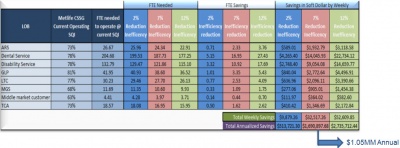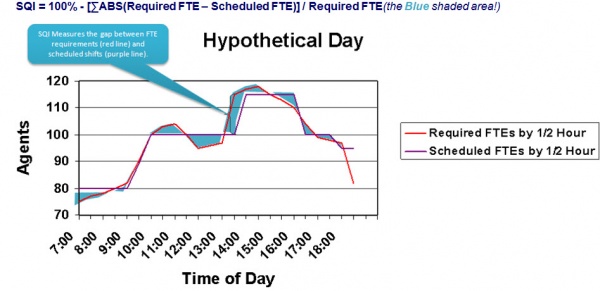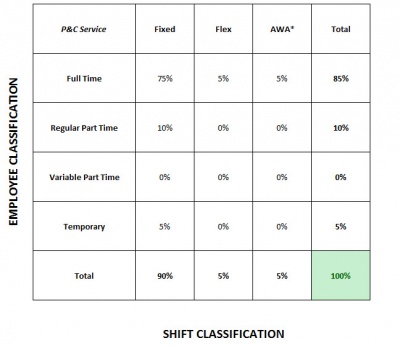Difference between revisions of "Establishing 2014 Scheduling Workshop"
| Line 168: | Line 168: | ||
''Because an AWA shift guarantees a specific schedule tailored to the employee's need, WFM requires contact center AVP or VP approval.'' | ''Because an AWA shift guarantees a specific schedule tailored to the employee's need, WFM requires contact center AVP or VP approval.'' | ||
| + | |||
| + | |||
| + | =Methodology= | ||
| + | |||
| + | ==Hours of Operation== | ||
| + | |||
| + | {| class="wikitable" | ||
| + | ! Service | ||
| + | ! Hrs of Op: M - F* | ||
| + | ! Hrs of Op: SAT* | ||
| + | ! Headcount (5/1) | ||
| + | |- | ||
| + | | ARC | ||
| + | | 8am-8pm | ||
| + | | Closed | ||
| + | | 72 | ||
| + | |- | ||
| + | | A&RS | ||
| + | | 8am-11pm | ||
| + | | Closed | ||
| + | | 29 | ||
| + | |- | ||
| + | | Dental | ||
| + | | 8am-11pm | ||
| + | | Closed | ||
| + | | 271 | ||
| + | |- | ||
| + | | Disability | ||
| + | | 8am-11pm | ||
| + | | Closed | ||
| + | | 108 | ||
| + | |- | ||
| + | | FCC | ||
| + | | 8am-7pm | ||
| + | | Closed | ||
| + | | 81 | ||
| + | |- | ||
| + | | GA&O | ||
| + | | 7:30am-8pm | ||
| + | | Closed | ||
| + | | 62 | ||
| + | |- | ||
| + | | GLP | ||
| + | | 8am-11pm | ||
| + | | Closed | ||
| + | | 57 | ||
| + | |- | ||
| + | | IAT | ||
| + | | 12am-12pm | ||
| + | | Open 24 X 7 | ||
| + | | 154 | ||
| + | |- | ||
| + | | IDI | ||
| + | | 8am-7pm | ||
| + | | Closed | ||
| + | | 13 | ||
| + | |- | ||
| + | | LTC | ||
| + | | 8am-11pm | ||
| + | | Closed | ||
| + | | 26 | ||
| + | |- | ||
| + | | Annuity - Legacy | ||
| + | | 9am-6pm | ||
| + | | Closed | ||
| + | | 96 | ||
| + | |- | ||
| + | | Annuity - Retail | ||
| + | | 8am-7pm | ||
| + | | Closed | ||
| + | | 231 | ||
| + | |- | ||
| + | | Life | ||
| + | | 8am-6pm | ||
| + | | Closed | ||
| + | | 98 | ||
| + | |- | ||
| + | | MGS | ||
| + | | 8am-10pm | ||
| + | | Closed | ||
| + | | 16 | ||
| + | |- | ||
| + | | P&C Service | ||
| + | | 8am-11pm | ||
| + | | 9am - 5pm | ||
| + | | 256 | ||
| + | |- | ||
| + | | TCA | ||
| + | | 8am-6pm | ||
| + | | Closed | ||
| + | | 32 | ||
| + | |} | ||
| + | |||
| + | {| class="wikitable" | ||
| + | ! Sales | ||
| + | ! Hrs of Op: M - F* | ||
| + | ! Hrs of Op: SAT* | ||
| + | ! Headcount (5/1) | ||
| + | |- | ||
| + | | MKS | ||
| + | | 8am-6pm | ||
| + | | Closed | ||
| + | | 9 | ||
| + | |- | ||
| + | | Multi Sales | ||
| + | | 8am-11pm | ||
| + | | Closed | ||
| + | | 19 | ||
| + | |- | ||
| + | | P&C Sales | ||
| + | | 8am - 10pm | ||
| + | | 9am - 4pm | ||
| + | | 333 | ||
| + | |} | ||
| + | |||
| + | *All Times are EST | ||
Revision as of 07:29, 12 June 2014
Contents
Introduction
Background: ROC Investment
As part of the ROC Program, CSC scheduling was identified as a work stream to support improved occupancy rates. Improved occupancy does not necessarily mean "higher" occupancy levels; the improvement instead is targeted at great stability in occupancy when viewed on an interval basis.
Scheduling efficiency gains were targeted $3.15 MM over 5 Years, leveraging these assumptions:
- Assumption - Fully loaded cost per FTE is $22.10 per hour
- Assumption - FTE weekly hours is 37.5 hours
- Life, Annuities and P&C are currently operating at SQI range of 83% - 87 %. These 3 products are not included in the table.
The ROC PAR Investment models moving SQI from 7% improvement to 12% improvement, $1.05MM Annual Savings
To calculate shift gains, a KPI called "Schedule Quality Index" (SQI) was used. SQI is used as a qualitative evaluation of schedule mixes with shift types and work rules to determine the efficiency of schedules created before they are assigned. SQI is calculated before CSCs are assigned to shifts and can therefore be calculated before any shift bid process is conducted to assign specialists to the schedules:
iGate conducted the analysis supporting the ROI calculations leveraged in the ROC Program. Execution against this ROC requires we introduce a ROC Scheduling Blueprint to introduce scheduling changes. These changes include:
- Introduce Shift Definitions which outlines employee classifications (Part Time, Part Time Variable, Full Time and Temporary Agents)
- As part of Shift Definitions, matrix Fixed, Flex and AWA Schedules against employee classifications
- Introduce a wider variety of Shift Tours
- Balance the schedule with Off phone activities and break optimization until you achieve the SQI step up target
This work stream has been launched as of April 2014, with focus currently on the creating and implementing the ROC Scheduling Blueprint.
Shift Definitions and The ROC
Ensuring efficient shift design and deployment is a critical element of the Resource Optimization Center program. Because a wide and varied "shift terminology" exists in the call center industry, we are creating a 2-dimensional definitions document to minimize confusion. The two dimensions leveraged are:
- Employee Classification
- Shift Type Classification
Employee Classifications
Employee classifications definitions are broken down and aligned under six types; full-time, regular part-time, variable part-time, temporary, contract associate, and intern. For contact center purposes, the job classifications for contract associate and intern will not be included as part of call center shift definitions.
The Fair Labor Standards Act (FLSA) does not define full-time employment or part-time employment. This is a matter generally to be determined by the employer. Whether an employee is considered full-time or part-time does not change the application of the FLSA. Additional reference Material US Department of Labor Fact Sheet #64 Call Centers under the Fair Labor Standards Act (FLSA)
Full Time (FT)
You are considered a full-time associate if you are regularly scheduled to work at least 40 hours a week and you are on the company payroll. You are eligible for benefits.
Regular Part-Time (RPT)
You are considered a regular part-time associate if you work a regular schedule of at least 20 hours a week with your salary prorated and salary-based benefits adjusted. You are eligible for benefits.
Variable Part-Time (VPT)
You are considered a variable part-time associate if you are hired to work a part-time schedule up to 1000 hours per anniversary year. An anniversary year begins when the associate is hired and ends the day before the anniversary date. You must also be on the company payroll and be considered a company associate. You are not eligible for benefits.
Temporary (TEMP)
You are considered a temporary associate if you are hired to work a regular full-time or part-time schedule for a limited period. You must also be on the company payroll and be considered a company associate. You are not eligible for benefits.
Shift Classifications
Call center shift classifications are broken down into three categories, which creates a 4x3 matrix of shift definitions. The 4 employee classifications x 3 shift classifications results 12 slot matrix in which all schedules align by line of business. The 3 shift classifications are Fixed Shift, Flex Shift, and Alternative Work Arrangement (AWA):
Fixed Shift
Fix shifts are assigned via a shift-bid process, or assigned to new hire employees prior to the first day of taking calls. Work patterns where hours of work, days worked, and time off are fixed and consistent. Fixed shifts are built by Workforce Management, and are loaded and administered in IEX. This pattern offers limited week to week flexibility to the scheduling team, and is generally optimized through either the addition of new hire classes, mini-bids, or full shift bids.
Examples of Fixed Shift Tours for Full-Time employees:
- Five 8-hour shifts
- Three 10-hour shifts and two 5-hour shifts
- 10 hours on peak day and 7.5 the rest of the week
- Four early 8-hour shifts and one late 8-hour shift each week
- Five split shifts, 4 hours in the morning, 4 hours in the evening
Examples of Fixed Shift Tours for Regular Part-Time employees:
- Five 4-hour shifts
- Three 10-hour shifts
- Four early 4-hour shifts and one late 4-hour shift each week
- Three 8-hour weekend shifts, Fri, Sat & Sun
Examples of Fixed Shift Tours for Variable Part-Time employees:
- Three 4-hour shifts (per week, all year - 624 annual hours)
- Five 3-hour shifts (per week, all year - 780 annual hours)
- Two 8-hour weekend shifts, Sat & Sun (832 annual hours)
- Five 8-hour shifts per week for November, December and January, followed by three 3-hour shifts per week Feb - Oct (840 annual hours)
Examples of Fixed Shift Tours for Temporary employees:
- Any of the above tour examples, applied to an employee hired for a limited time period.
Flex Shift
Flex shifts are assigned via a shift-bid process, or agreed upon for new hires prior to the first day of taking calls. Work patterns where hours of work, days worked, and time off are fixed in nature, but can flex on a week to week basis. Flex shifts are built by Workforce Management, and are loaded and administered in IEX. This pattern offers greater week to week flexibility to the scheduling team, in that the start and stop time of the hours worked may "flex" or move up to 2 hours. The flexing takes place during schedule runs, allowing the employee > 2 week notice to any changes in their start and stop times.
Examples of Flex Shift Tours for Full-Time employees:
- Five 8-hour shifts M-F, 8am-4:30pm for June's schedules, 9:00-5:30 for July's schedules.
- Three 10-hour shifts and two 5-hour shifts. Each 10-hour shift runs 8:00-6:30 in June and July, while the 5 hour shifts run 8-1:30 in June, and 9-2:30 in July.
Flex Shift employees have priority selections for shift-bids, mini-bids, VTO and OT.
Alternative Work Arrangement (AWA)
Alternative Work Arrangement (AWA) shifts are custom shift patterns required to meet special needs of an employee. This shift pattern could be any tour within the fixed shift inventory, or could be a customized schedule.
Examples of AWA Shift Tours for Full-Time employees:
- Three 10-hour shifts 8am-6:30, Tues-Friday, Off Sat-Sun-Mon
- Five 8-hour shifts, 8am-4:30 M-Thur, 7am-3:30 Friday
AWA employees have lowest priority selections for VTO and OT.
Shift Definition Matrix
By Line Of Business, WFM leverages hourly and daily call arrival patterns, volume variability (intraday, daily and week over week), AHT variability (intraday, daily and week over week), attrition hazards, learning curves and other statistical factors to determine the approximate mix of shift tour types to build in IEX. The number of tour combinations is theoretically limitless, however is limited by examining the hours of operation and days of week in which calls are serviced.
Daily, weekly and seasonal variability will also approximate the employee classification mix %'s; higher intraday variability week over week will result in higher recommended flex shifts, where high seasonality variability will result in higher recommended temporary employees.
When the matrix is presented by call type, the % of total tours will be designated as below:
| P&C Service | Fixed | Flex | AWA* | Total |
|---|---|---|---|---|
| Full Time | 75% | 5% | 5% | 85% |
| Regular Part Time | 10% | 0% | 0% | 10% |
| Variable Part Time | 0% | 0% | 0% | 0% |
| Temporary | 5% | 0% | 0% | 5% |
| Total | 90% | 5% | 5% | 100% |
This scenario recommends 75% Fixed Full-Time Shift Tours, 5% Flex Full-Time Shift Tours, 5% AWA Full-Time Shift Tours, and 5% Fixed Temporary Shift Tours.
Because an AWA shift guarantees a specific schedule tailored to the employee's need, WFM requires contact center AVP or VP approval.
Methodology
Hours of Operation
| Service | Hrs of Op: M - F* | Hrs of Op: SAT* | Headcount (5/1) |
|---|---|---|---|
| ARC | 8am-8pm | Closed | 72 |
| A&RS | 8am-11pm | Closed | 29 |
| Dental | 8am-11pm | Closed | 271 |
| Disability | 8am-11pm | Closed | 108 |
| FCC | 8am-7pm | Closed | 81 |
| GA&O | 7:30am-8pm | Closed | 62 |
| GLP | 8am-11pm | Closed | 57 |
| IAT | 12am-12pm | Open 24 X 7 | 154 |
| IDI | 8am-7pm | Closed | 13 |
| LTC | 8am-11pm | Closed | 26 |
| Annuity - Legacy | 9am-6pm | Closed | 96 |
| Annuity - Retail | 8am-7pm | Closed | 231 |
| Life | 8am-6pm | Closed | 98 |
| MGS | 8am-10pm | Closed | 16 |
| P&C Service | 8am-11pm | 9am - 5pm | 256 |
| TCA | 8am-6pm | Closed | 32 |
| Sales | Hrs of Op: M - F* | Hrs of Op: SAT* | Headcount (5/1) |
|---|---|---|---|
| MKS | 8am-6pm | Closed | 9 |
| Multi Sales | 8am-11pm | Closed | 19 |
| P&C Sales | 8am - 10pm | 9am - 4pm | 333 |
- All Times are EST


